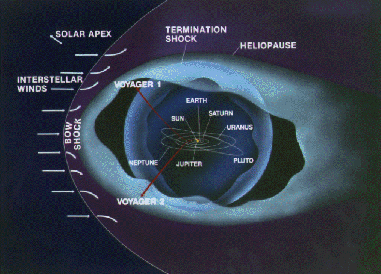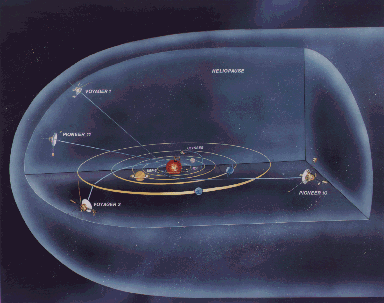Mission Objective
The mission objective of the Voyager Interstellar
Mission (VIM) is to extend the NASA exploration of the
solar system beyond the neighborhood of the outer
planets to the outer limits of the Sun's sphere of
influence, and possibly beyond. This extended mission is
continuing to characterize the outer solar system
environment and search for the heliopause boundary, the
outer limits of the Sun's magnetic field and outward
flow of the solar wind. Penetration of the heliopause
boundary between the solar wind and the interstellar
medium will allow measurements to be made of the
interstellar fields, particles and waves unaffected by
the solar wind.

Mission Characteristic
The VIM is an extension of the Voyager primary mission
that was completed in 1989 with the close flyby of
Neptune by the Voyager 2 spacecraft. Neptune was the
final outer planet visited by a Voyager spacecraft.
Voyager 1 completed its planned close flybys of the
Jupiter and Saturn planetary systems while Voyager 2, in
addition to its own close flybys of Jupiter and Saturn,
completed close flybys of the remaining two gas giants,
Uranus and Neptune.
At the start of the VIM, the two
Voyager spacecraft had been in flight for over 12 years
having been launched in August (Voyager 2) and September
(Voyager 1), 1977. Voyager 1 was at a distance of
approximately 40 AU (Astronomical Unit - mean distance
of Earth from the Sun, 150 million kilometers) from the
Sun, and Voyager 2 was at a distance of approximately 31
AU.
As of July 2003, Voyager 1 was at a
distance of 13.3 Billion Kilometers (88 AU) from the sun
and Voyager 2 at a distance of 10.6 Billion kilometers
(70 AU).
Voyager 1 is escaping the solar system
at a speed of about 3.6 AU per year, 35 degrees out of
the ecliptic plan to the north, in the general direction
of the Solar Apex (the direction of the Sun's motion
relative to nearby stars). Voyager 2 is also escaping
the solar system at a speed of about 3.3 AU per year, 48
degrees out of the ecliptic plane to the south.
Both Voyagers are headed towards the
outer boundary of the solar system in search of the
heliopause, the region where the Sun's influence wanes
and the beginning of interstellar space can be sensed.
The heliopause has never been reached by any spacecraft;
the Voyagers may be the first to pass through this
region, which is thought to exist somewhere from 8 to 14
billion miles from the Sun. Sometime in the next 5
years, the two spacecraft should cross an area known as
the termination shock. This is where the
million-mile-per-hour solar winds slows to about 250,000
miles per hour—the first indication that the wind is
nearing the heliopause. The Voyagers should cross the
heliopause 10 to 20 years after reaching the termination
shock. The Voyagers have enough electrical power and
thruster fuel to operate at least until 2020. By that
time, Voyager 1 will be 12.4 billion miles (19.9 billion
KM) from the Sun and Voyager 2 will be 10.5 billion
miles (16.9 billion KM) away. Eventually, the Voyagers
will pass other stars. In about 40,000 years, Voyager 1
will drift within 1.6 light years (9.3 trillion miles)
of AC+79 3888, a star in the constellation of
Camelopardalis. In some 296,000 years, Voyager 2 will
pass 4.3 light years (25 trillion miles) from Sirius,
the brightest star in the sky . The Voyagers are
destined—perhaps eternally—to wander the Milky Way. For
current distances, check:
Mission Weekly Reports
It is appropriate to consider the VIM
as three distinct phases: the termination shock,
heliosheath exploration, and interstellar exploration
phases. The two Voyager spacecraft began the VIM
operating, and are still operating, in an environment
controlled by the Sun's magnetic field with the plasma
particles being dominated by those contained in the
expanding supersonic solar wind. This is the
characteristic environment of the termination shock
phase. At some distance from the Sun, the supersonic
solar wind will be held back from further expansion by
the interstellar wind. The first feature to be
encountered by a spacecraft as a result of this
interstellar wind/solar wind interaction will be the
termination shock where the solar wind slows from
supersonic to subsonic speed and large changes in plasma
flow direction and magnetic field orientation occur.

Passage through the termination shock
ends the termination shock phase and begins the
heliosheath exploration phase. While the exact location
of the termination shock is not known, it is very
possible that Voyager 1 will complete the termination
shock phase of the mission between the years 2001 and
2003 when the spacecraft will be between 80 and 90 AU
from the Sun. Most of the current estimates place the
termination shock at around 85 ± 5 AU. After passage
through the termination shock, the spacecraft will be
operating in the heliosheath environment which is still
dominated by the Sun's magnetic field and particles
contained in the solar wind. The heliosheath exploration
phase ends with passage through the heliopause which is
the outer extent of the Sun's magnetic field and solar
wind. The thickness of the heliosheath is uncertain and
could be tens of AU thick taking several years to
traverse. Passage through the heliopause begins the
interstellar exploration phase with the spacecraft
operating in an interstellar wind dominated environment.
This interstellar exploration is the ultimate goal of
the Voyager Interstellar Mission.
|